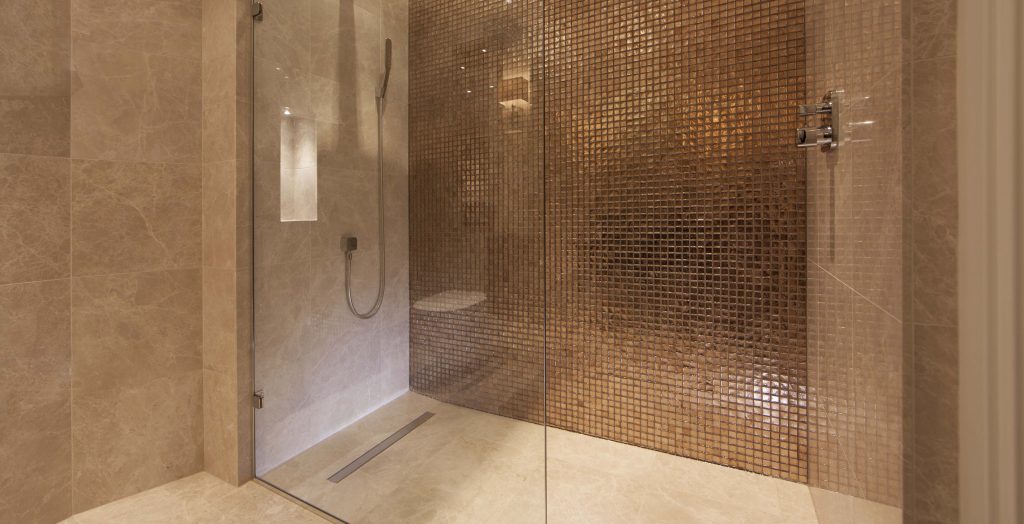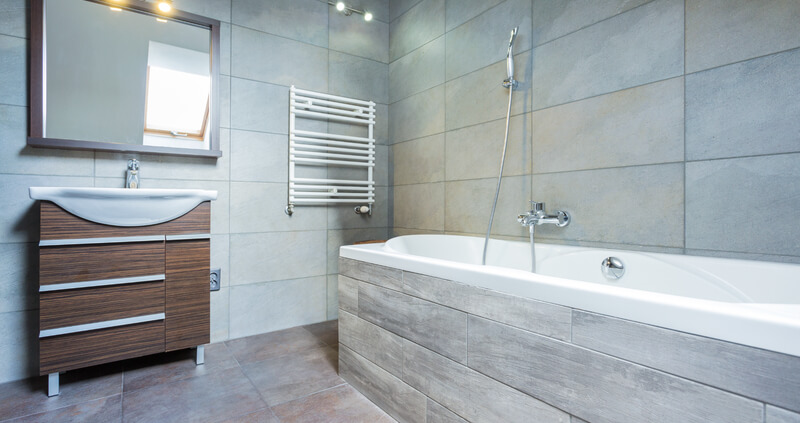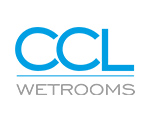Installing a wet room in your home will provide a number of benefits. Take advantage of having more design options, having a space that’s easier to clean, and an aspirational bathroom that you’ll never want to leave! Wet rooms benefit everyone, young and old alike. Read on to find out about eight of the biggest advantages of wet rooms.

8 Key Benefits of Having a Wetroom
1. Wetrooms give you more design options
Wetrooms give you the advantage of really flexing your creative muscles. With fewer obstructions such as shower trays and fixed cubicles, plus a more open-plan, sophisticated feel, you can take your bathroom design into a new direction.
Get creative with your use of lighting and materials. Will you go for a soft, spa design with lots of wood and low ambient light? Or will you choose a sleek, modern design that uses steel and glass? The choice is yours.
2. Wetrooms provide high aesthetic value
It’s undeniable that wet rooms add a wow factor to any property. Wall to ceiling tiling, minimalist fixtures, and an open plan design, all ooze simplicity and contemporary elegance. This can boost the luxury feel of a hotel room or could be the deciding factor in guests choosing your Airbnb property over another. Never underestimate the power of a stunning wetroom!
3. Increase the value of your property with a wetroom
It’s known that luxury homes go up in value if they have a wet room. Their sleek design and suitability for both young families and those with mobility problems will often make your home more attractive to potential buyers. Plus, since they’re easy to clean, you’ll benefit in having some extra time on your hands.
4. Wetrooms offer great space-saving
Wetrooms are a great space-saving solution for small properties. You get all the benefits of a functional, practical shower space without the need for bulky fittings and fixtures. You can even make the most of unusual architectural features, such as a sloping ceiling in a Victorian property, by installing an open plan wetroom with a glass screen, something that would not be possible to achieve with a standard shower enclosure. They also give you the option of getting more out of a small second bathroom or en-suite.
5. Wetrooms are easy to clean
Another advantage of having fewer fixtures and fittings and all that space, is that your bathroom becomes incredibly easy to clean. Shower enclosures are notorious for gathering dirt and grime in their runners and creases, making them tricky to keep clean. Wetrooms simply don’t have this problem.
If your wetroom design includes a wall-mounted toilet and floating basin, you have a bathroom floor completely free from obstacles and clutter. This makes sweeping and mopping a breeze. Find out more about keeping wetrooms clean.
6. Wetrooms provide greater accessibility
Although not always designed with this in mind, a level entry wetroom is ideal for those whose movement is limited, such as the elderly or disabled. There is no need for stepping up into a shower tray, making access to the shower much easier. When fitted with non-slip tiles, wetrooms are a safe option for all ages. Learn more about easy access wet rooms.
7. Wetrooms last longer
Due to the waterproofing systems fitted under the tiles of wetrooms, a correctly installed wetroom is extremely resistant to moisture damage and leaks. This means less maintenance and a bathroom that looks newer for longer. High quality wetroom products will come with a lifetime guarantee.
8. Wetrooms are easily customisable
Wetrooms represent a modern way of doing things. Consumers now have choices and can get what they want at prices they can afford. Wetrooms can be built in any number of configurations and made to fit in any size en suite, from those in hotel rooms to those in mansions. Plus, when it comes to wetroom materials, there are attractive options available in a wide variety of price ranges.

5 Disadvantages of Wetrooms
Common issues that often go hand in hand with having a wetroom installed include drainage problems, excess water spills and damp, and impacted property resale potential (for those who want a bathtub). However, it’s worth bearing in mind that many of these practical ‘issues’ often arise from improper installation done by inexperienced installers, as when installed correctly, drainage and waterproofing issues are an extremely rare occurrence.
1. Excess spray and water spills
In wetrooms, there is what is known as a ‘splash zone’, which is essentially the area that gets the most splashback from the water. This is often the shower area itself and at least a metre on all sides. For smaller wetrooms, this means the entire wetroom may be considered a ‘splash zone’ and will need full waterproofing. Smaller wetrooms will definitely feel ‘wetter’ than a small bathroom’.
However, excess spray and water spills are often caused by a shower installed at a bad angle for the tile format, or poorly installed tiles at a bad angle. Not only is the angle of the floor in the wetroom shower important, but it’s also important to consider the type of tiles you are using. Make sure to speak to an expert wetroom designer, who can advise you best on all these elements.
2. Slippery floors
Slippery floors are a common concern for property owners installing a wetroom. As the entire floor is often tile, people are concerned that there will be an increase in slips and falls, especially for those with mobility issues.
However, there are some steps that you can take to reduce the slipperiness of tiles and increase your peace of mind, but you can also ensure that any tile you choose has a good score on the pendulum test.
3. Dampness/excess moisture
More often a concern in smaller wetrooms, or those in ensuites, dampness and excess moisture can be a worry. However, due to stricter ventilation requirements in new builds, and the advanced technology now available in ventilation, dampness and steam should not be a problem. For older properties, poor ventilation may still be a problem, and you may need to install better ventilation when introducing a wetroom.
Similarly, a thorough tanking process ensures that any excess water does not affect the structure of the building. If tiles have been installed badly, or shortcuts have been made when waterproofing, then this will be where the issues are.
4. Potential drainage issues
As wetrooms have no distinction between the showering area and the rest of the room, poor drainage installation can quickly become a problem. This can lead to pooling water and will increase the risk of slipping.
To this effect, it is advisable to over specify drains if you are nearing the flow rate limit. This will prevent any problems with drainage and will ensure that any users will be kept safe from overly wet floors.
5. Can make reselling property harder
Wetrooms can hinder the sale of a property in some cases – which is solely down to differing preferences. For young families and those with babies, a bath is needed. Some people also just prefer the flexibility of a bath and shower.
To overcome this, you should consider installing a bath as part of your wetroom if you have the space. This will allow the flexibility wanted while maintaining the good benefits of a wetroom.
Discover How CCL Wetrooms Can Help
With the help of an expert fitter and industry-leading materials, installing a wet room is simple. CCL Wetrooms provide a range of superior wet room products, including drainage and waterproofing membranes, designed to make installation easier. Contact us today for technical advice on designing and installing a watertight wetroom in your property.









